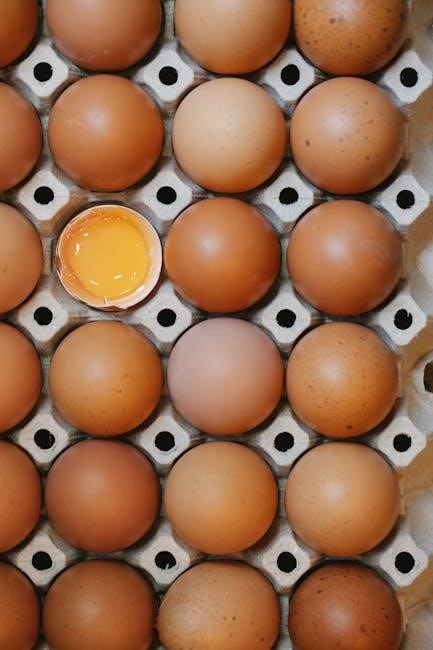Borel sets are fundamental in measure theory and topology, forming a sigma-algebra generated by open sets․ They provide a foundational framework for understanding measurable spaces and events․
Overview of Borel Sets
Borel sets are the smallest sigma-algebra generated by the open sets in a topological space․ They form a foundational structure in measure theory and probability, enabling the definition of measurable events․ Generated through countable unions, intersections, and complements of open sets, Borel sets provide a universal framework for analyzing spaces․ Their properties make them essential in various mathematical fields, including real analysis and topology, offering a systematic way to describe complex set structures․
Importance of Borel Sets in Measure Theory
Borel sets are crucial in measure theory as they form the foundation for defining measures like the Lebesgue measure․ They provide a structure for assigning probabilities or lengths to sets, making them essential in probability theory and real analysis․ The sigma-algebra of Borel sets ensures that all open sets and their countable combinations are measurable, enabling the construction of measures on topological spaces․ This framework is fundamental for understanding measurable functions and events in advanced mathematical analysis․
Definition of Borel Sets
Borel sets are subsets of a topological space forming a sigma-algebra generated by open sets, including all countable unions and intersections․
Borel Sets in Topological Spaces
Borel sets are subsets of a topological space that belong to the sigma-algebra generated by its open sets․ They are constructed by taking countable unions, intersections, and complements of open sets․ This structure ensures that Borel sets are closed under fundamental operations, making them essential in defining measurable spaces․ In any topological space, the collection of Borel sets forms a sigma-algebra, which is crucial for measure theory and probability, providing a foundation for defining measures like Lebesgue measure․
The Role of Sigma-Algebras in Defining Borel Sets
Sigma-algebras play a crucial role in defining Borel sets as they provide a formal structure for collections of subsets․ By definition, a sigma-algebra is closed under countable unions, intersections, and complements․ Borel sets are specifically the elements of the sigma-algebra generated by the open sets of a topological space․ This means that all operations on open sets, such as countable unions and intersections, result in Borel sets, making sigma-algebras indispensable in their definition and study․

Borel Hierarchy
The Borel hierarchy classifies sets based on their construction from open sets using countable unions and intersections․ It forms a progression of sets, starting with open sets and building complexity․
Classification of Borel Sets
Borel sets are classified into a hierarchy based on their construction using countable operations․ Starting with open sets (σ-algebra), they extend through countable unions and intersections․ The hierarchy includes classes like Gδ sets (countable intersections of open sets) and Fσ sets (countable unions of closed sets)․ This classification system organizes sets by their complexity, forming a detailed structure within measure theory and topology․
Examples of Borel Sets in Different Classes
Open sets, such as intervals (a, b), are basic Borel sets․ Closed sets, like [a, b], are also Borel․ Gδ sets, formed by countable intersections of open sets, include examples like {1/n | n ∈ ℕ}․ Fσ sets, countable unions of closed sets, include the rational numbers in [0,1]․ More complex Borel sets arise from countable unions and intersections, showcasing the hierarchy’s depth and versatility in topology and measure theory․

Properties of Borel Sets
Borel sets are closed under countable unions and intersections․ They include all open and closed sets in a topological space, forming a foundational structure for measure theory․
Closure Properties of Borel Sets
Borel sets are closed under countable unions, intersections, and complements․ This means that any countable combination of Borel sets, such as open or closed sets, remains a Borel set․ For example, the countable union of open sets is open, and the countable intersection of closed sets is closed․ Additionally, the complement of any Borel set is also a Borel set․ These closure properties ensure that Borel sets form a sigma-algebra, making them essential in measure theory and probability․
Relation to Open and Closed Sets
Borel sets encompass all open and closed sets in a topological space․ Open sets are fundamental, as the Borel sigma-algebra is generated by them․ Conversely, closed sets, being complements of open sets, are also Borel․ Every open or closed set is inherently a Borel set․ However, not all Borel sets are necessarily open or closed, as they can be formed through countable unions, intersections, or complements of such sets․ This relationship underscores the foundational role of open and closed sets in constructing Borel sets․

Borel Sigma-Algebra
The Borel sigma-algebra is the smallest sigma-algebra containing all open sets․ It includes open, closed, and complex sets formed by countable unions and intersections in mathematical spaces․
Generation of Borel Sigma-Algebra
The Borel sigma-algebra is generated by the open sets in a topological space․ It is constructed by closing the collection of open sets under countable unions, intersections, and complements․ This process ensures that all sets formed by these operations are included, creating a rich structure for measurable events․ The Borel sigma-algebra is the smallest sigma-algebra containing the topology, making it fundamental in measure theory and probability․
Smallest Sigma-Algebra Containing Open Sets
The Borel sigma-algebra is the smallest sigma-algebra that contains all open sets in a topological space․ It is unique in this minimality, as no smaller sigma-algebra can encompass all open sets while remaining closed under countable unions and intersections․ This property makes it foundational in measure theory and probability, serving as the standard collection of measurable sets for many applications․

Borel Measures
Borel measures are defined on Borel sets in a topological space, forming a cornerstone of measure theory and probability․ They are essential for assigning probabilities or lengths to these sets․
Definition and Properties of Borel Measures
Borel measures are measures defined on the Borel sigma-algebra of a topological space․ They assign a non-negative real number to each Borel set, satisfying countable additivity․ Regular Borel measures exhibit inner and outer properties, linking open and closed sets․ These measures are fundamental in probability theory and analysis, enabling the study of stochastic processes and integrals on structured spaces․
Regular Borel Measures
Regular Borel measures are characterized by their ability to approximate the measure of Borel sets using open and closed sets, ensuring a harmonious interaction between measure theory and topology․ They are crucial in probability and analysis, enabling the definition of integrals and stochastic processes․ Examples include Lebesgue measure, which is both inner and outer regular, highlighting their importance in well-behaved measures that align with the topological structure of the space․

Applications of Borel Sets
Borel sets are pivotal in probability theory, enabling the definition of probability measures․ They also play a key role in real analysis and topology, facilitating advanced mathematical frameworks․
Role in Probability Theory
Borel sets are foundational in probability theory, serving as the basis for defining sigma-algebras on sample spaces․ They enable the assignment of probabilities to events, ensuring measurability․ By generating sigma-algebras from open sets, Borel sets provide a structured framework for probabilistic analysis․ This is crucial for defining random variables and understanding stochastic processes․ Their properties facilitate the construction of probability measures, making them indispensable in both theoretical and applied probability․ Borel sets thus underpin the mathematical rigor required in modern probability theory and its applications․
Applications in Real Analysis and Topology
Borel sets play a crucial role in real analysis and topology, providing a framework for studying measurable spaces․ They are essential in defining measurable functions and understanding the structure of topological spaces․ In real analysis, Borel sets help classify sets based on their complexity, while in topology, they are used to analyze the properties of spaces and mappings․ Their applications extend to the study of Polish spaces, where Borel sets form the basis of standard measurable structures․ This makes them indispensable in both fields for advancing theoretical and applied research․

Advanced Topics in Borel Sets
Borel sets in product spaces and universal Borel sets explore complex measurable structures, extending classical measure theory into advanced descriptive set theory and its applications․
Borel Sets in Product Spaces
Borel sets in product spaces are generated by the product topology, extending measurable structures to higher dimensions․ The Borel sigma-algebra on product spaces is the smallest sigma-algebra making all projections measurable․ This concept is crucial in measure theory and probability, enabling the study of complex events in multi-dimensional settings․ It also plays a key role in functional analysis and stochastic processes, providing a rigorous framework for analyzing product measurable spaces․
Universal Borel Sets and Their Properties
Universal Borel sets are invariant under Borel isomorphisms, preserving their measurable structure across spaces․ They play a crucial role in measure theory and probability, offering a consistent framework for analyzing events․ Their properties ensure compatibility with continuous transformations, making them essential in advanced analytic settings․ Universal Borel sets are fundamental in understanding the deep connections between topology and measure theory, providing a bridge between abstract spaces and practical applications in stochastic processes and functional analysis․
Borel sets form the cornerstone of measure theory and probability, providing a rigorous framework for defining measurable events․ Their structure, derived from open sets in topological spaces, ensures compatibility with continuous transformations․ The properties and classifications of Borel sets, such as their closure under countable unions and intersections, make them indispensable in advanced mathematical analysis․ Their universal nature bridges topology and measure theory, offering a consistent foundation for understanding complex spaces and stochastic processes․
